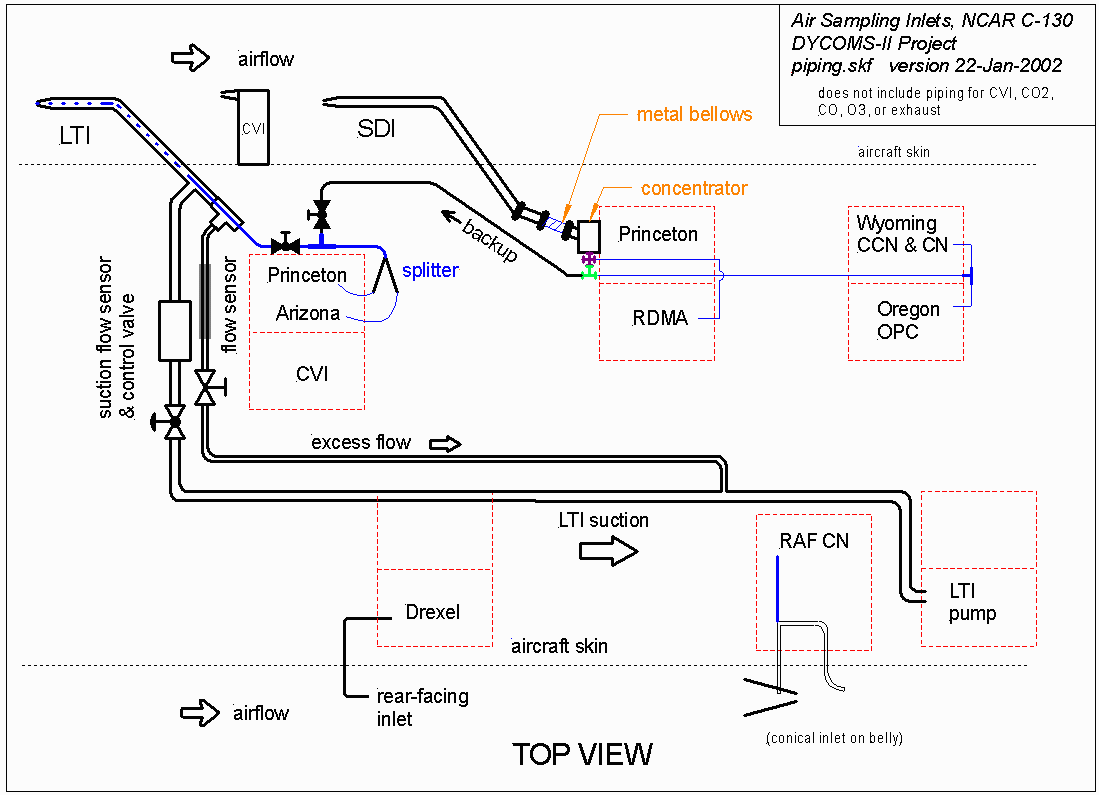
by David C. Rogers
update: 21-Jan-2002| jump to | LTI | SDI | CN |
This document describes the air sampling arrangement for RAF, Princeton, Arizona, Oregon and Wyoming instruments on the NCAR C-130 during DYCOMS-II. Four inlets were used to bring ambient air samples inside the cabin: LTI, SDI, CVI, and CN-cone. The LTI, SDI, and CN-cone are briefly described here. The CVI instrument is described in other documentation and a CVI flow chart from Cynthia Twohy (send email) for the DYCOMS-II project. In addition to these particle inlets, there were aft-facing inlets for trace gas measurements (O3, DMS, CO, CO2); they are not described here. Only the CVI had the capability for heating to prevent icing in supercooled water clouds. The LTI, SDI and CVI were located near each other on the fuselage (see photo, compliments of Hiroshi Tagaki).
This diagram is a plan view of the piping in the C-130 cabin; the forward part of the cabin is to the left, and starboard is at the top. Both the LTI and SDI were operated iso-kinetically (velocity at the inlet tip matched the airspeed). A backup branch was installed to provide sample air from the SDI if the LTI failed during flight. In the case of LTI failure, the SDI could be selected to provide air to the front rack by closing the valve from the LTI and simultaneously opening the valve from the SDI. These were 3/8" stainless steel ball valves. In none of the DYCOMS-II flights did the LTI fail, and the backup branch was never used.
In this diagram, larger lines indicate larger diameter piping and greater
flow rates.

The Low Turbulence Inlet (LTI) provided sample air to front rack instruments (Princeton and Arizona). It uses boundary-layer suction in the inlet tip to reduce the loss of large particles (> 1µm) due to turbulence. As a result, the concentrations of large particles are enhanced in the core flow. Air for the particle impactors was extracted from the core flow, as shown in the LTI detail view.
Sketch shows geometry of sample pick-off and tubing leading to splitter and impactors.
Total LTI flow was much larger than needed by the particle impactors, as shown in the following table; most of the flow was discarded as excess sample. Total flow (suction + excess) was automatically controlled to maintain isokinetic sampling at the inlet tip. Suction flow was automatically controlled to reduce turbulence in the diffuser inlet.
instrument |
location |
flow (LPM) |
| Princeton streaker | rack 1 | 2 |
| Arizona impactor & streaker | rack 1 | 4 |
| excess sample | LTI suction | 110 |
| TOTAL LTI | 116 |
The Solid Diffuser Inlet (SDI) provided an independent sample to two racks as shown in the figure. The SDI is a conical diffuser that expands from 0.238" (0.60cm) to 1.25" (3.18cm) diameter with ~3.5° half-angle. The air flow came through large-diameter tubing (1.25") to the base of the Princeton Concentrator where samples were drawn off through a 3/8" SS tee and cross for the RDMA (in the same rack) and the Wyoming and Oregon instruments (in the next rack aft), SDI detail view.
Sample air from the SDI was divided among several different instruments. The total was 194 vLPM.
instrument |
location |
flow (LPM) |
| Princeton filters | rack 2 | 180 |
| RDMA | rack 2 | 5 |
| Wyo CCN | rack 3 | 6 |
| Wyo CN (2) | rack 3 | 2 |
| Oregon OPC | rack 3 | 1 |
| TOTAL SDI | 194 |
Flow rates for isokinetic sampling with the SDI were calculated over a range of airspeeds typical for the C-130, as shown in the following table. Isokinetic sampling conditions for 194 vLPM at the SDI tip were achieved for airspeeds ~113 m s-1. Non-isokinetic sampling occurred when the aircraft speed was different from 113 m s-1 or during occasional interruptions for changing sample media or servicing instruments.
| C-130 airspeed (m s-1) | 103 | 108 | 113 | 124 | 134 |
| SDI isokinetic flow (vLPM) | 177 | 186 | 195 | 214 | 231 |
Paul Baron's AeroCalc.xls spreadsheet (available from TSI) was used to estimate the iso-axial inlet sampling efficiency for the SDI 0.238" inlet at the same air speeds. Non-isokinetic conditions are estimated to cause errors less than 5% for sub-micron sampling as shown in table.
| SDI iso-axial inlet sampling efficiencies |
| particle diameter (µm) | 103 | 108 | 113 | 124 | 134 |
| 10 | 0.656 | 0.758 | 0.963 | 0.991 | 1.016 |
| 5 | 0.817 | 0.880 | 0.987 | 1.006 | 1.023 |
| 2 | 0.926 | 0.954 | 0.997 | 1.005 | 1.013 |
| 1 | 0.967 | 0.980 | 0.999 | 1.003 | 1.007 |
| 0.5 | 0.986 | 0.991 | 1.000 | 1.001 | 1.003 |
Concentration measurements of condensation nuclei (CN) were made by Wyoming using two TSI-3010 instruments in the Wyoming rack and by RAF using a TSI-3760 instrument in a different rack, as shown above. The Wyoming CN sample air came from the starboard SDI. The RAF CN sample air came from a separate inlet on the belly of the C-130 (see photo 1 and photo 2). RAF CN data are in netcdf files as variable CONCN.
As shown in the detail view, this belly inlet drew air from the centerline of a forward-facing cone into a tube perpendicular to the cone axis. Compared to other inlets, this device has shown less susceptibility to produce CN as artifacts when droplets splash on the leading edge of the inlet.